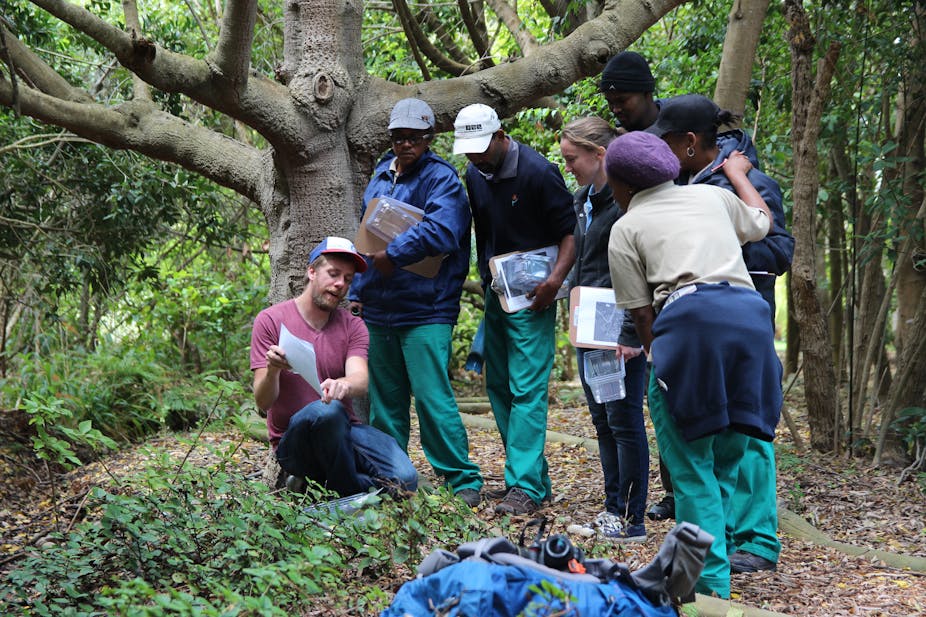Plant diseases threaten food security and sustainability. They affect ecosystems and change natural environments. They cost money, too. An enormous amount is spent globally each year to control these diseases; the damage they cause is also hugely expensive. For example, crop losses from plant killing microbes are estimated to have cost the US $33 billion per year according to a 2005 report.
New plant disease epidemics are emerging all the time. Myrtle rust is an example of a disease recently identified in South Africa. It now threatens natural areas containing Myrtaceous plants and is of concern for many forestry industries growing Australian Eucalyptus species.
The emergence of new plant disease epidemics is largely driven by globalisation. Humans are the major pathway of spreading microbes that cause plant disease. But people are generally unaware of the risk and potential of their movement since the microbes in question are microscopic. We can’t see them, so we don’t think much about them.
The effect of plant disease could be reduced if people are made more aware of the many pathways for plant-killing microbes – and why preventing their spread matters to us all.
That’s where citizen science projects, such as Cape Citizen Science, can help. Citizen science projects are opportunities to release our inner scientist to expand scientific literacy and knowledge. Cape Citizen Science believes that everyone has a little bit of scientist in them.
Plant-destroying microbes
Researchers involved in the project invited the public to join up as “pathogen hunters” to find a group of plant-destroying microbes known as Phytophthora which was responsible for one of the worst plant disease epidemics known to humanity, the Irish potato famine. The responsible organism, Phytophthora infestans, starved nearly a quarter of Ireland’s population and drove another quarter out of the country in the mid 1800s.
Phytophthora species are also well known around the world for the diseases they cause in natural forests. Through epidemics such as Sudden Oak Death in the US and Jarrah (Phytophthora) dieback in Australia, they are known for eliminating susceptible species from the environment.
Cape Citizen Science facilitates research about Phytophthora species in South Africa’s Cape floristic region in the extreme south western tip of Africa. Many species of plants are threatened in this biodiversity hotspot, which is often recognised as the “hottest hotspot” because of the exceptional degree of endemism, housing thousands of species that don’t naturally occur anywhere else on the planet. But little is known about the impact of Phytophthora on Cape Flora. The project aims to create a baseline of data about Phytophthora species diversity and distribution.
It’s important to survey the diversity of Phytophthora species in this region because there may be many that have never been discovered. There may also be many species that are known to science but have never been discovered in South Africa. And finally, it’s important to survey these organisms in a bid to detect a newly arrived species before it causes too much damage.
Citizen scientist contributions
Nearly 200 people have been involved as citizen scientists since the project launched in 2016. They contribute by reporting dying plants and submitting samples. Many reports and samples have come from areas that the researchers would not have found.
Citizens report dying plants using the online tool Ispot Nature. Many observations have been added to the Cape Citizen Science project and, again, include several that would not have been found by the scientists alone.
Ordinary people can also get involved by submitting samples of dying plants, soil, and even collections of microbes growing on petri-plates provided by the project. Samples have been submitted from home gardens, plant productions and recreational activities.
The project also offers workshops so citizens can learn to recognise and sample plant disease. Each workshop starts with a presentation about the research, incorporates a hike to find sick plants and ends with an activity to isolate and culture the microscopic organisms.
This format is also the basis for educational activities organised with children. The project has involved youth such as the Helderberg Eco-rangers and is currently organising activities with the South African Education and Environment Project and Vision Afrika. These activities are a way to inspire the next generation of naturalists and scientists.
Citizen science projects have exceptional merit for the early detection of new plant disease epidemics. By incorporating many observers, more observations are made across space and time – and at a relatively low cost. And citizen science works: the Myrtle rust pathogen in South Africa was first discovered through a citizen’s report.
Opportunities for growth
Cape Citizen Science is an example of a grassroots project that has built a community of citizen scientists. It’s supported by the DST-NRF Centre of Excellence in Tree Health Biotechnology, the Forestry and Agricultural Biotechnology Institute, University of Pretoria, and Stellenbosch University.
Although our work is regional, the model could be implemented on a larger scale and in other countries. Hopefully this project will serve as an example and a learning platform to help other research areas and other countries establish their own projects to involve more citizens.

